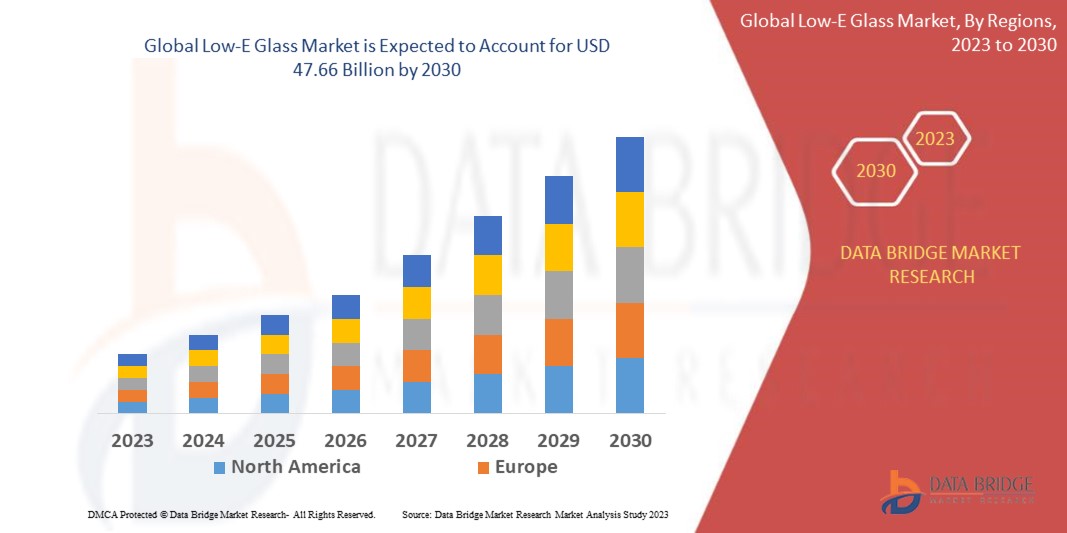Energy-Efficient Building Solutions Propel Expansion of the Global Low-E Glass Market
"Detailed Analysis of Executive Summary Low-E Glass Market Size and Share
Data Bridge Market Research analyses that the global low-e glass market, which was USD 25.75 billion in 2022, is expected to reach USD 47.66 billion by 2030, growing at a CAGR of 8.0% during the forecast period of 2023 to 2030.

This Low-E Glass Market report serves you with the bigger picture of the marketplace as it studies market and the industry by considering several aspects. This market report gives an absolute background analysis of the industry along with an assessment of the parental market. To achieve sustainable growth in the market, businesses must be well-versed with the specific and most relevant product and market information in the Low-E Glass Market The resources used for collecting the data and information that is included in this report are very trustworthy and range from journals, company websites, and white papers etc.
Being professional and comprehensive, this Low-E Glass Market report focuses on primary and secondary drivers, market share, leading segments, possible sales volume, and geographical analysis. This market report also analyzes the market status, market share, current trends, growth rate, future trends, market drivers, opportunities and challenges, risks and entry barriers, sales channels, and distributors. The Low-E Glass Market report clearly explains what market definition, classifications, applications, engagements and market trends are for the Low-E Glass Market industry. This market report provides explanation about the detailed market analysis with inputs from industry experts. The Low-E Glass Market report presents data on patterns and improvements, and target business sectors and materials, limits and advancements.
Take a deep dive into the current and future state of the Low-E Glass Market. Access the report:
https://www.databridgemarketresearch.com/reports/global-low-e-glass-market
Low-E Glass Market Data Summary
**Segments**
- Based on the coating type, the low-E glass market can be segmented into hard-coat low-E glass and soft-coat low-E glass. Hard-coat low-E glass is manufactured by baking the coating into the glass during production, making it more durable and suitable for external applications. Soft-coat low-E glass, on the other hand, is applied to the glass surface in a vacuum chamber after the glass has been manufactured, providing better thermal insulation.
- On the basis of glazing type, the market can be categorized into single glazing, double glazing, and triple glazing. Single glazing consists of a single pane of glass, providing basic thermal insulation. Double glazing includes two panes of glass with a space filled with inert gas in between, offering improved insulation. Triple glazing, with three glass panes and two insulating spaces, provides the highest level of thermal efficiency.
- By application, the low-E glass market can be segmented into residential construction, commercial construction, and others. Residential construction applications include windows, doors, and skylights, where energy-efficient low-E glass plays a vital role in reducing heat loss. In commercial construction, low-E glass is used in facades, storefronts, and curtain walls to enhance energy savings and occupant comfort.
**Market Players**
- Asahi India Glass Limited
- AGC Inc.
- Nippon Sheet Glass Co., Ltd.
- Saint-Gobain
- Central Glass Co., Ltd.
- SCHOTT AG
- Vitro, S.A.B. de C.V.
- Guardian Industries
- Xinyi Glass Holdings Limited
- Taiwan Glass Ind. Corp.
The global low-E glass market is witnessing significant growth attributed to the increasing focus on energy-efficient buildings and sustainable construction practices. With the rising awareness about environmental conservation and stringent regulations regarding energy efficiency in buildings, the demand for low-E glass is expected to surge in the coming years. The construction industry is a major driving force behind the market growth, particularly in regions with extreme climatic conditions where thermal insulation is crucial for maintaining indoor comfort and reducing energy consumption.
The adoption of low-E glass is also driven by its ability to regulate heat gain and loss, thereby reducing the reliance on artificial heating and cooling systems. This not only lowers energy bills for consumers but also contributes to reducing overall carbon emissions. The market for low-E glass is also benefiting from technological advancements in glass manufacturing processes, leading to the development of high-performance coatings that offer superior thermal insulation while maintaining optical clarity.
Furthermore, the increasing focus on green building certifications such as LEED (Leadership in Energy and Environmental Design) is driving the integration of low-E glass in architectural projects to meet sustainability requirements. Market players are investing in research and development activities to enhance the performance characteristics of low-E glass and expand their product portfolios to cater to diverse end-user requirements.
Overall, the global low-E glass market is poised for steady growth, supported by the growing emphasis on energy efficiency, sustainable construction practices, and technological advancements in glass manufacturing. Market players are focusing on strategic collaborations, product innovations, and geographical expansion to strengthen their market presence and capitalize on the evolving demand for energy-efficient building materials.
The global low-E glass market is currently experiencing a notable expansion, driven by the increasing emphasis on energy efficiency and sustainability in the construction sector. One of the key factors fueling market growth is the growing awareness of environmental conservation and the implementation of stringent regulations aimed at enhancing energy efficiency in buildings. This has led to a heightened demand for low-E glass products, especially in regions with extreme climatic conditions where effective thermal insulation is essential for maintaining indoor comfort levels and reducing energy consumption.
In addition to regulatory drivers, the adoption of low-E glass is also being propelled by its ability to regulate heat gain and loss, thereby reducing the need for artificial heating and cooling systems. This not only results in cost savings for end-users but also contributes to a reduction in overall carbon emissions. Moreover, advancements in glass manufacturing technologies are playing a significant role in the development of high-performance coatings that offer superior thermal insulation without compromising optical clarity, further boosting the demand for low-E glass products in the market.
Another vital growth driver for the low-E glass market is the increasing focus on green building certifications such as LEED, which require the incorporation of energy-efficient materials like low-E glass in construction projects to meet sustainability standards. Market players are actively engaging in research and development initiatives to enhance the performance attributes of low-E glass and diversify their product offerings to cater to a wide range of end-user needs.
Looking ahead, the global low-E glass market is set to witness sustained growth as the construction industry continues to prioritize energy efficiency and sustainable building practices. Market participants are strategically collaborating, introducing innovative products, and expanding their geographical footprint to strengthen their market position and capitalize on the evolving demand for energy-efficient construction materials. With a favorable regulatory environment, technological advancements, and a growing focus on sustainability, the low-E glass market is poised for steady expansion in the foreseeable future.The global low-E glass market is witnessing a profound transformation driven by the escalating demand for energy-efficient solutions in the construction industry. One of the key factors fueling the market growth is the increasing awareness among consumers and industry players about the significance of environmental sustainability and energy conservation in building design and operation. As the world grapples with the challenges of climate change, there is a growing emphasis on reducing carbon footprints and enhancing energy efficiency, which has propelled the adoption of low-E glass as a crucial component of green building practices.
Moreover, the evolving regulatory landscape, with stringent mandates and building codes focusing on energy performance and sustainability, is pushing construction companies and architects to integrate energy-efficient materials like low-E glass into their projects. Low-E glass, with its ability to regulate heat transfer and improve thermal insulation, not only contributes to reducing energy consumption and operational costs but also aids in creating healthier and more comfortable indoor environments for occupants.
Furthermore, technological advancements in glass manufacturing processes have revolutionized the capabilities of low-E glass, enabling the development of coatings that offer superior thermal performance while maintaining optical clarity. This has expanded the application scope of low-E glass beyond traditional residential and commercial buildings to specialized constructions such as high-rise towers, healthcare facilities, and educational institutions, driving further growth in the market.
The increasing focus on sustainability certifications and green building standards like LEED has also been instrumental in boosting the demand for low-E glass products, as they are essential for achieving energy efficiency goals and environmental benchmarks. Market players are investing in research and development initiatives to innovate new product solutions that meet evolving performance requirements and cater to diverse customer needs across different segments of the construction industry.
Overall, the global low-E glass market is poised for continued expansion as the world transitions towards a more sustainable and energy-conscious future. With innovations in coatings, glazing technologies, and applications, low-E glass is set to play a pivotal role in shaping the next generation of energy-efficient buildings and infrastructure projects worldwide. Market participants are expected to focus on collaboration, innovation, and market penetration strategies to capitalize on the growing demand for sustainable construction materials and establish a strong foothold in this dynamic market landscape.
Investigate the company’s industry share in depth
https://www.databridgemarketresearch.com/reports/global-low-e-glass-market/companies
Low-E Glass Market Overview: Strategic Questions for Analysis
- What is the size of the global Low-E Glass Market industry this year?
- What rate of growth is forecasted for the next decade for Low-E Glass Market?
- What are the key divisions of the Low-E Glass Market?
- Which organizations have the strongest presence in Low-E Glass Market?
- Which markets are the focus of the geographic analysis for Low-E Glass Market ?
- What companies are featured in the competitive landscape for Low-E Glass Market?
Browse More Reports:
Middle East and Africa Aesthetic Dermatology Market
Global Perovskite Solar Cell Market
Global Ready to Drink (RTD) Alcoholic Beverages Market
Global Aesthetic Dermatology Market
Global Coffee Machines Market
Global Endometriosis Market
Global Ethylbenzene Market
Global Furniture Fittings Market
Global Industrial Oxygen Market
Global Mineral Oils Market
Global Nanotechnology Market
Global Non Alcoholic Beverages Market
Global Quinoa Market
Global RNA Therapeutics Market
Global Robusta Coffee Beans Market
Global Automotive Engine Heat Shield Market
About Data Bridge Market Research:
An absolute way to forecast what the future holds is to comprehend the trend today!
Data Bridge Market Research set forth itself as an unconventional and neoteric market research and consulting firm with an unparalleled level of resilience and integrated approaches. We are determined to unearth the best market opportunities and foster efficient information for your business to thrive in the market. Data Bridge endeavors to provide appropriate solutions to the complex business challenges and initiates an effortless decision-making process. Data Bridge is an aftermath of sheer wisdom and experience which was formulated and framed in the year 2015 in Pune.
Contact Us:
Data Bridge Market Research
US: +1 614 591 3140
UK: +44 845 154 9652
APAC : +653 1251 975
Email:- corporatesales@databridgemarketresearch.com
"
- Marketing & Social Media
- AI & Digital Tools
- Science & Innovation
- Business & Finance
- Education & Learning
- Technology & Gadgets
- Family & Relationships
- Parenting & Kids
- Fashion & Beauty
- Travel & Culture
- News & Politics
- Home
- Literature
- Music
- Networking
- Other
- Party
- Religion
- Shopping
- Sports
- Theater
- Wellness
- Art
- Causes
- Crafts
- Dance
- Drinks
- Film
- Fitness
- Food
- Gardening
- Health
- Games



